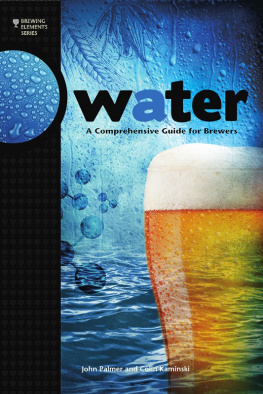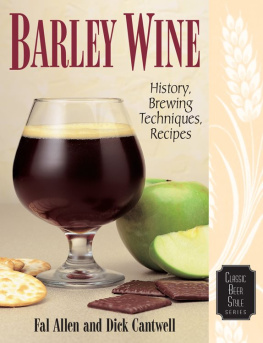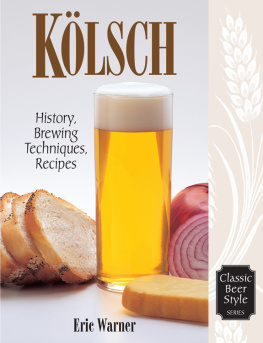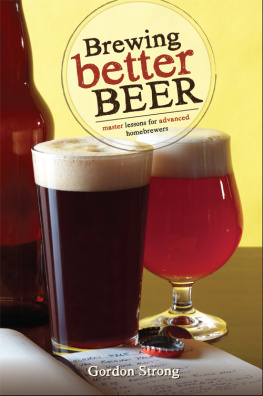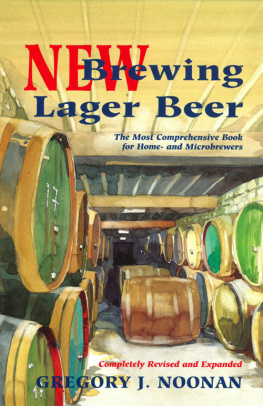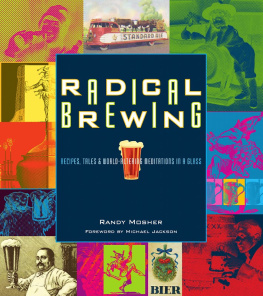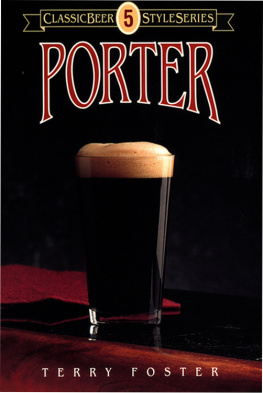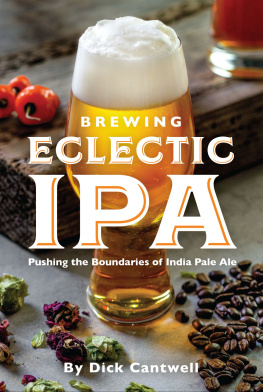

A Comprehensive Guide for Brewers
John Palmer and Colin Kaminski

Brewers Publications
A Division of the Brewers Association
PO Box 1679, Boulder, Colorado 80306-1679
www.BrewersAssociation.org
www.BrewersPublications.com
Copyright 2013 by Brewers Association
All rights reserved. No portion of this book may be reproduced in any form without written permission of the publisher. Neither the authors, editors nor the publisher assume any responsibility for the use or misuse of information contained in this book.
ISBN: 978-0-937381-99-1 (print)
ISBN: 978-1-938469-10-7 (ePub)
Library of Congress Cataloging-in-Publication Data for the Print Edition
Palmer, John J., 1963
Water : a comprehensive guide for brewers / by John Palmer and Colin Kaminski.
p. cm.
Includes bibliographical references and index.
ISBN 978-0-937381-99-1 (pbk.)
1. Brewing. 2. Water use. 3. Water chemistry. 4. Water--Purification. I. Kaminski,
Colin, 1965- II. Title.
TP583.P35 2013
546.22--dc23
2013019177
Publisher: Kristi Switzer
Technical Editors: A. J. deLange, Martin Brungard
Copy Editing: Amahl Turczyn Scheppach
Indexing: Doug Easton
Production and Design Management: Stephanie Johnson Martin
Cover and Interior Design: Julie White
Cover Illustration: Alicia Buelow
To all those who have so generously shared their knowledge and passion for brewing with me, thank you for letting me return the favor.
-John
I would like to thank all those people who believed in me to make my life possible. I would also like to thank all those people who did not believe in me for giving me the drive to achieve my accomplishments.
-Colin
List of Key Figures, Tables, Sidebars and Illustrations
Acknowledgments
No book can be written without managing time. We eagerly volunteered to spend this time but we must thank our families for the time we missed with them. We embarked on this voyage several years ago hoping to collect all of the worlds knowledge of brewing water together in one place, and in so doing, unlock brewings last frontier. We found instead that water was much deeper and broader than we had imagined. That water puns surfaced wherever we turned. We feared we were out of our depth. But with lots of friends to turn to for help, we believe we have compiled a useful book for all brewers.
Both of us started brewing about twenty years ago in the early nineties, and both of us were inspired to learn more about brewing water from the writing of one particular man, A. J. deLange. He was the first person we knew of that took water chemistry beyond 2+2=4 and introduced us to the carbo system, to solubility constants, and milliequivalents. He was the first to warn us that we were missing the point trying to replicate famous brewing waters, that the compositions were not realistic, that they did not add up. His work has enabled us to pursue water science in our brewing careers and brought us to where we are today. Throughout this project, as we would get stuck on a topic, or realize there was an unknown elephant in the. It is our conviction that A. J. deLange has done more to help brewers understand water than anyone since Paul Kolbach introduced the concept of residual alkalinity in 1953.
We must also greatly thank Martin Brungard for his expertise and wisdom. Martin is a Diplomate of Water Resources Engineering, and has been guiding brewers in water use since 1999. Martin was instrumental in the technical review of the content, always bringing us back to what was practical, applicable, and verifiable in any brewery setting.
John needs to personally thank Bob Hansen and Dan Bies at Briess Malting and Ingredients for all of their hard work testing the distilled water pH and acidity of various malts. This project consumed nearly four years as we puzzled over the data, and planned and conducted new trials. Likewise, Kai Troester, a self-made brewing scientist, has generously shared his work and ideas on testing malt acidity and predicting mash pH. Most of would not have been possible without their help.
Colin needs to personally thank Gil Sanchez, Ian Ward, Brian Hunt, Dr. Michael Lewis and Dr. Charles Bamforth for always offering advice in brewing chemistry while he negotiated difficult waters. (Pun intended.) He also needs to thank the Northern California chapter of the Master Brewers Association for providing endless contacts and technical lectures that made his brewing career possible.
We absolutely need to thank the workers and brewers of Stone Brewing Co., New Belgium Brewing Co., Coors Brewing Co., Golden, The Bruery, Eagle Rock Brewery, Golden Road Brewery, Firestone Walker Brewing Co., Moonlight Brewery, Bells Brewery, Founders Brewery, Anheuser-BuschFairfield, and last but not least Sierra Nevada Brewing Co., for their generosity in answering questions, phone calls, and personal tours as we tried to sort out all of the options and practices of water usage today. We must also thank the many brewers who helped us over the years by asking questions and inviting us to speak at conferences. Every question and discussion has helped us keep our oars in the water.
Lastly, we would like to recommend the NALCO Water Handbook for anyone tasked with managing water treatment at any brewery. This 1,000+ page book is an encyclopedia of everything in water treatment. It may not cover breweries specifically, but it covers everything else.
Foreword
I have been involved with brewing for perhaps 40 years and in that time I have acquired many books. Some of them include Briggs Malts and Malting, Neves Hops, White and Zainasheffs Yeast, the Practical Guide to Beer Fermentation (also included in the Brewing Elements Series) and Jacksons Applied Water and Spentwater Chemistry. These books all contain valuable information about the major raw materials used to make beer, but the first three are plainly written for brewers. The fourth is not. The word brewing does not even appear in its index. The same is true for several other water titles and several on yeast (though brewing does get mentioned in most of the yeast books). I have lots of books on water, but I dont have one on brewing water. You do. You are holding it in your hands, and as soon as my copy comes from the printer, I will too. Mine will go in the space Im reserving for it, next to the yeast, hops and malt books.
Why has it taken so long to get a brewing water book on the shelf? Simple: it is hard to write one! I speak from experience. I have from time to time tried to write a book on this subject and found it so intricate that at times I felt I was fighting the Hydra. Every time one head got cut off two more grew back. Im pretty sure that if you ran into John or Colin at a conference or anywhere else and asked either of them if the task turned out to be more daunting than they originally thought, they would answer, Yes!
Then there is the question of readership. I am not sure that many people would have been interested in this book 40 years ago. The demand is strong now. Ive had lots of, Whens the water book coming out? queries. I believe the reason for this is that the sophistication of hobby and craft brewers has advanced dramatically, and this I attribute to advances in technology. The four technologies I have in mind are computers, reverse osmosis systems, pH meters and the Internet. All but the last were well established 40 years ago. While the first three are not new technologies, they have enjoyed huge increases in performance accompanied by dramatic decreases in price. Lets defer discussion of the influence of RO and pH meters for the time being and comment on the influence of the Internet and, necessarily, the computers with which we access the Internet.
Next page
